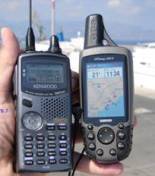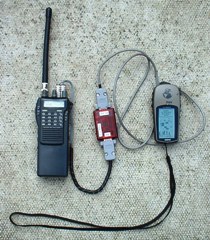Taking APRS out for a walk
Transmitting APRS on the move
 One of the main uses of APRS is to transmit regular position reports (obtained from a GPS unit) from mobile stations: either vehicles or pedestrians.
One of the main uses of APRS is to transmit regular position reports (obtained from a GPS unit) from mobile stations: either vehicles or pedestrians.
The Kenwood TH-D7 handie transceiver has a built-in TNC and APRS support, so all that is required is to connect in the GPS receiver and set off on your journey.
These radios are out of production now, but are still widely available second-hand.
To interface with any other FM transceiver, an extra unit is required, either a TNC or a "tracker": see this section for more details.
 The picture shows
my OT1 tracker (the red box in the picture) connected to an old Alinco handie. The Tracker draws less than 20mA from the radio's battery supply, and the GPS has its own internal battery, so it's a compact solution for pedestrian operation. I can carry the GPS in a pouch on the shoulder strap (so that it has good visibility of the sky), and the little helical aerial can also be clipped onto the strap on my shoulder.
The picture shows
my OT1 tracker (the red box in the picture) connected to an old Alinco handie. The Tracker draws less than 20mA from the radio's battery supply, and the GPS has its own internal battery, so it's a compact solution for pedestrian operation. I can carry the GPS in a pouch on the shoulder strap (so that it has good visibility of the sky), and the little helical aerial can also be clipped onto the strap on my shoulder.
I set up my Tracker to send transmissions at regular intervals (200 or 300 seconds), or I can use the SmartBeaconing mode, where the transmissions are more frequent the faster the I move, or when I turn a corner. The Open Tracker can be loaded with two different configurations, which can be switched by fitting a jumper on the PCB (or with an external switch).
For further notes on APRS configuration and digipeating, see
this page, and I've also put together a "cut-out and keep"
quick-start guide for Trackers.
Right, I'm ready to go! You can see where I've been recently by looking at the
DB0ANF site. This reports my most recent positions relayed via an internet gateway.
Happy tracking!
Burst-after-voice mode
Trackers, and the Kenwood D-series sets, can be set to operate in burst-after-voice mode.
Here, instead of sending out position packets automatically at pre-set intervals, the data burst is sent when the PTT is released. This mode can be used on a telephony net, where stations equipped with APRS displays can see where the transmitter is, but others on the net just hear the APRS data as a modulated pip-tone at the end of each over.
In this instance, to keep the burst as short as possible, use compressed mode for the data, and keep the text comment brief.
See this page for details of how to set up your Tracker to do this.
 One of the main uses of APRS is to transmit regular position reports (obtained from a GPS unit) from mobile stations: either vehicles or pedestrians.
One of the main uses of APRS is to transmit regular position reports (obtained from a GPS unit) from mobile stations: either vehicles or pedestrians.